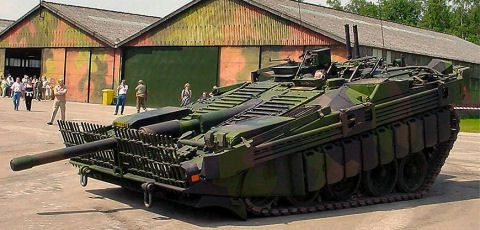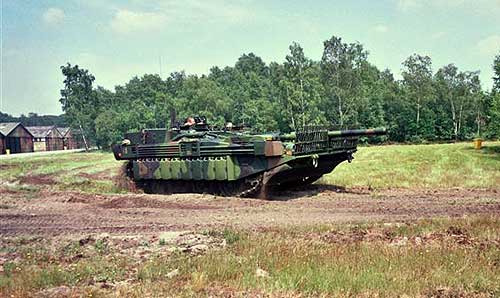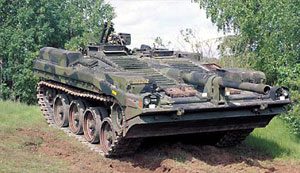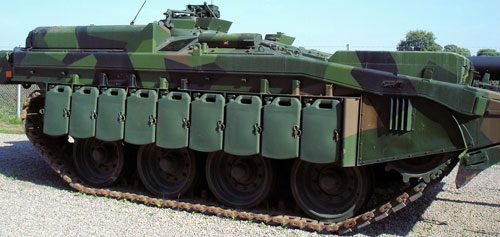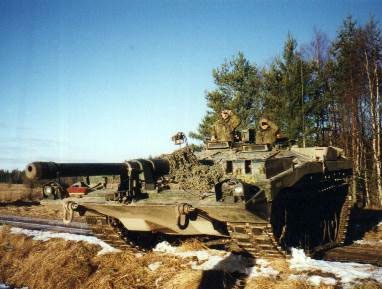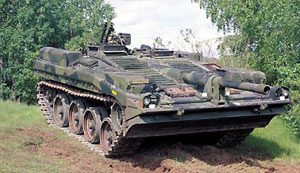
Main battle tank Strv-103
Content
Main battle tank Strv-103(S-Tank or Tank 103)
The Swedish army currently needs 200-300 new main tanks. Three options for solving this problem were discussed: either create your own new tank, or purchase the required number of tanks abroad (almost all major tank-building countries offer their tanks), or organize the production of a selected foreign tank under license using some Swedish components in its design. To implement the first option, Bofors and Hoglund organized a group that developed a technical proposal for the creation of the Stridsvagn-2000 tank. A tank weighing 58 tons with a crew of 3 people, a large-caliber cannon (possibly 140 mm), a 40-mm automatic cannon paired with it, an anti-aircraft 7,62-mm machine gun, should have armor protection of a modular design that provides a high level of security. The mobility of the tank should be no worse than that of the main modern tanks due to the use of a 1475 hp diesel engine. with., automatic transmission, hydropneumatic suspension, which allows, among other things, to change the angular position of the machine in the longitudinal plane. To reduce the time and money for development, existing components should be used in the design: engine, transmission, machine guns, elements of fire control systems, protection against weapons of mass destruction, etc., but only the chassis assembly, the main armament and its automatic loader should be created anew. At the end of the 80s, the Swedish firms Hoglund and Bofors began to develop the Stridsvagn-2000 tank, which was planned to replace the outdated Centurion. A life-size model of this tank was even made, but in 1991 the leadership of the Ministry of Defense closed the Stridsvagn-2000 project in connection with the decision of the Swedish government to purchase the main battle tank abroad.
The M1A2 "Abrams", "Leclerc tanks" and "Leopard-2" tanks participated in the competitive tests. However, the Germans offered better delivery terms, and their vehicle outperformed American and French tanks in tests. Since 1996, the Leopard-2 tanks began to enter the Swedish ground forces. In the early 80s, Swedish specialists created and tested prototypes of a light articulated tank, designated SHE5 XX 20 (it was also called a tank destroyer). Its main armament is a German 120-mm smoothbore gun (with a Bofors muzzle brake). It is placed above the body of the front tracked vehicle, which also accommodates the crew (three people). The second car has a 600 hp diesel engine. with., ammunition and fuel. With a total combat weight of just over 20 tons, this tank reached speeds of up to 60 km / h during tests on snowy terrain, but it remained in the prototype stage. In 1960, the Bofors company received an army order for 10 prototypes, and in 1961 presented two prototypes. After improvements, the tank was put into service under the designation "5" and put into production in 1966.
Due to unusual layout solutions, the designers managed to combine high security, firepower and good mobility in a tank with a limited mass. The requirement to combine high security and firepower in the design of the tank with good mobility with a limited mass was satisfied by the designers primarily due to unusual layout solutions. The tank has a reckless layout with a "casemate" installation of the main armament in the hull. The gun is installed in the frontal hull sheet without the possibility of pumping vertically and horizontally. Its guidance is carried out by changing the position of the body in two planes. In front of the machine is the engine compartment, behind it is the control compartment, which is also combat. In the habitable compartment to the right of the gun is the commander, to the left is the driver (he is also a gunner), behind him, facing the stern of the car, is the radio operator.
The commander has a low-profile 208° turret with a single hatch cover. The stern of the car is occupied by an automatic gun loader. The adopted layout scheme made it possible to conveniently place the 105-mm rifled gun 174 manufactured by Bofors in a limited volume. Compared to the base model, the 174 barrel is extended to 62 calibers (against 52 calibers for the English). The gun has a hydraulic recoil brake and a spring knurler; barrel survivability - up to 700 shots. The ammunition load includes unitary shots with armor-piercing sub-caliber, cumulative and smoke shells. Carried ammunition is 50 shots, of which - 25 with sub-caliber shells, 20 with cumulative and 5 with smoke.
The immobility of the gun relative to the body made it possible to use a relatively simple and reliable automatic loader, which ensured the technical rate of fire of the gun up to 15 rounds / min. When reloading the gun, the spent cartridge case is ejected through a hatch in the stern of the tank. In combination with an ejector installed in the middle part of the barrel, this significantly reduces the gas contamination of the habitable compartment. The automatic loader is reloaded manually through two aft hatches and takes 5-10 minutes. Guidance of the gun in the vertical plane is carried out by the longitudinal swing of the hull due to the adjustable hydropneumatic suspension, in the horizontal plane - by turning the tank. Two 7,62-mm machine guns with 2750 rounds of ammunition are mounted on the left side of the front plate in a fixed armored casing. Guidance of machine guns is carried out by the body, i.e. machine guns play the role of coaxial with a cannon, in addition, a sighting 7,62-mm machine gun was installed on the right. Cannons and machine guns are fired by the tank commander or driver. Another machine gun is mounted on the turret above the vehicle commander's hatch. From it you can fire both at air and at ground targets, the turret can be covered by armored shields.
The commander of the vehicle and the driver have binocular combined optical devices ORZ-11, with variable magnification. A Simrad laser rangefinder is built into the gunner's sight. The commander's device is stabilized in the vertical plane, and its turret is in the horizontal plane. In addition, interchangeable periscope blocks are used. The commander has four blocks - they are installed along the perimeter of the commander's cupola, one driver (to the left of ORZ-11), two radio operators. Optical devices on the tank are covered with armored shutters. The security of the machine is ensured not only by the thickness of the armor of the welded hull, but also by the large angles of inclination of the armored parts, primarily the upper front plate, the small area of the frontal and side projections, and the trough-shaped bottom. A significant factor is the low visibility of the vehicle: of the main battle tanks in service, this combat vehicle has the lowest silhouette. To protect against enemy observation, two four-barreled 53-mm smoke grenade launchers are located on the sides of the commander's cupola. A hatch for the evacuation of the crew is made in the hull. On tank The 81P / -103 cannon is also installed in the frontal sheet of the hull without the possibility of pumping vertically and horizontally. Its guidance is carried out by changing the position of the body in two planes.
The performance characteristics of the main battle tank STRV - 103
Sources:
| ||||||||||||||||||||||||||||||||||||||||
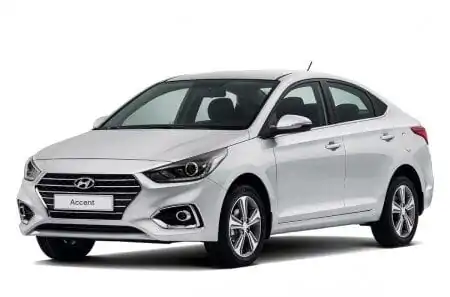
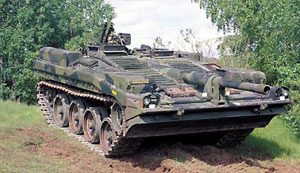 For the first time in the post-war years, no new tanks were developed in Sweden. In 1953, 80 Centurion Mk 3 tanks with 83,4 mm guns, designated 51P / -81, were purchased from the UK, and later about 270 Centurion MK 10 tanks with 105 mm guns were purchased. However, these machines did not fully satisfy the Swedish army. Therefore, from the mid-50s, a study began on the possibility and expediency of creating our own tank. At the same time, the military leadership proceeded from the following concept: a tank is an absolutely necessary element in the Swedish defense system at the present time and in the foreseeable future, especially for protecting open areas in the south of the country and along the coast of the Baltic Sea. Features of Sweden a small population (8,3 million people) with a large territory (450000 km2), the length of the borders (1600 km from north to south), numerous water barriers (over 95000 lakes), a short period of service in the army. Therefore, the Swedish tank should have better protection than the Centurion tank, surpass it in firepower, and the tank's mobility (including the ability to overcome water obstacles) should be at the level of the best world models. In accordance with this concept, the 51P / -103 tank, also known as the “5” tank, was developed.
For the first time in the post-war years, no new tanks were developed in Sweden. In 1953, 80 Centurion Mk 3 tanks with 83,4 mm guns, designated 51P / -81, were purchased from the UK, and later about 270 Centurion MK 10 tanks with 105 mm guns were purchased. However, these machines did not fully satisfy the Swedish army. Therefore, from the mid-50s, a study began on the possibility and expediency of creating our own tank. At the same time, the military leadership proceeded from the following concept: a tank is an absolutely necessary element in the Swedish defense system at the present time and in the foreseeable future, especially for protecting open areas in the south of the country and along the coast of the Baltic Sea. Features of Sweden a small population (8,3 million people) with a large territory (450000 km2), the length of the borders (1600 km from north to south), numerous water barriers (over 95000 lakes), a short period of service in the army. Therefore, the Swedish tank should have better protection than the Centurion tank, surpass it in firepower, and the tank's mobility (including the ability to overcome water obstacles) should be at the level of the best world models. In accordance with this concept, the 51P / -103 tank, also known as the “5” tank, was developed.